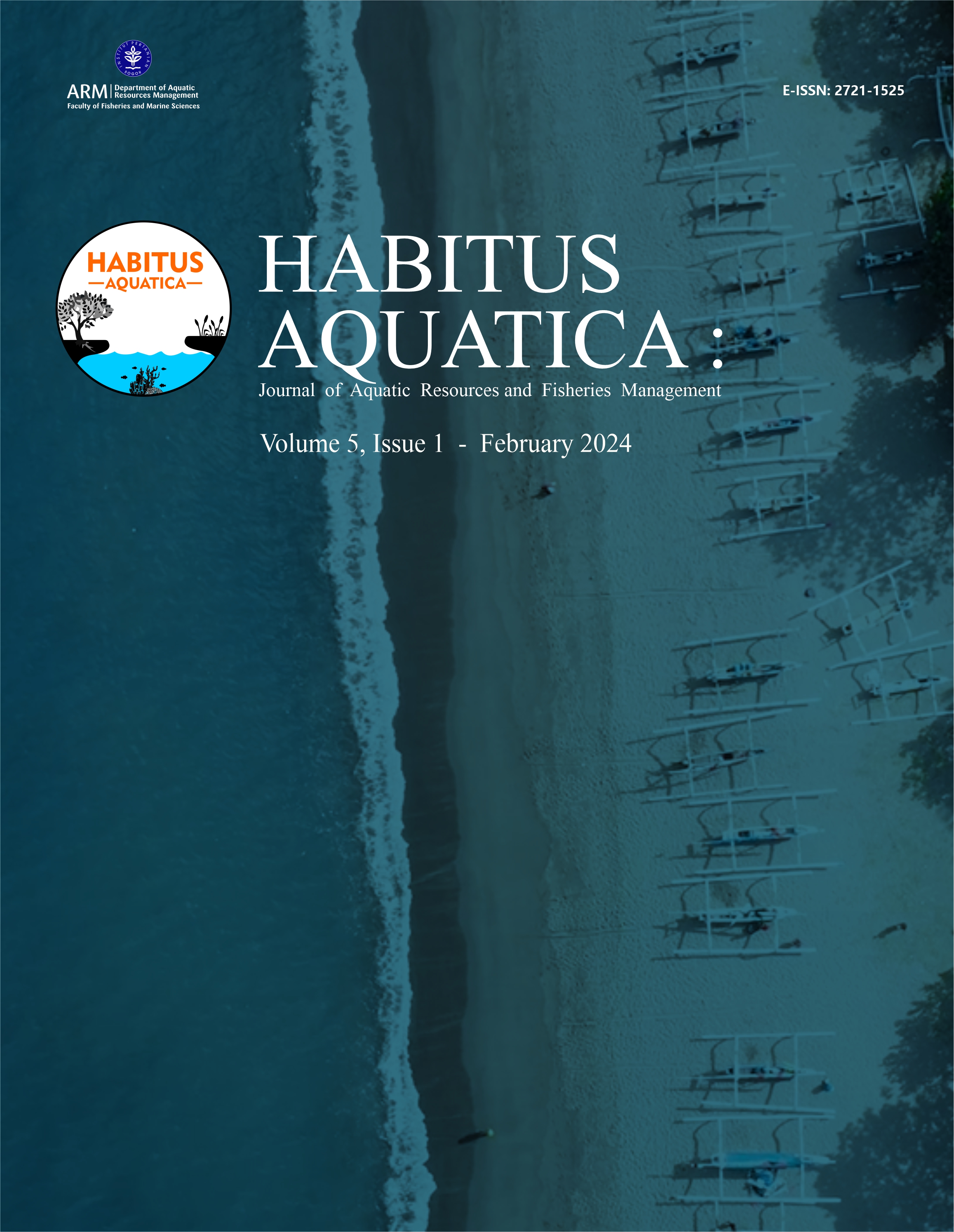Phytoplankton Community Structure in Palabuhanratu Bay
Struktur Komunitas Fitoplankton di Perairan Teluk Palabuhanratu
Abstract
Phytoplankton, as autotrophic organisms, play a role as primary producers and are often used to measure the fertility of a body of water. Palabuhanratu Waters, which has fishing resources, experiences various human activities in its vicinity. This study aims to determine the community structure in Palabuhanratu Waters. Phytoplankton samples were collected in October 2022 from four stations, and water parameters such as temperature, salinity, pH, and dissolved oxygen (DO) were measured. Six classes and 27 genera of phytoplankton were found, including Dinophyceae, Bacillariophyceae, Oligotrichea, Chlorophyceae, Polycystina, and Trebouxiophyceae, with Bacillariophyceae being the dominant class. The abundance of phytoplankton was relatively low, ranging from 66 to 695 ind/l. The diversity index was classified as moderate, with values ranging from 1,552 to 2,234. The water parameters indicated that the conditions still support the growth of phytoplankton.
Downloads
References
Adharini RI, Probosunu N, Satriyo TB. 2021. Kelimpahan dan struktur komunitas plankton di Sungai Pasir dari Kabupaten Kulon Progo (Yogyakarta) hingga Purworejo (Jawa Tengah). LIMNOTEK Perairan Darat Tropis di Indonesia. 28(2): 71–82.
Ayuningsih MS, Hendrarto IB, Purnomo PW. 2014. Distribusi kelimpahan fitoplankton dan kolorofil-a di Teluk Sekumbu Kabupaten Jepara: hubungannya dengan kandungan nitrat dan fosfat di perairan. Diponegoro Journal of Maquares. 3(2): 138–147.
Azis A, Nurgayah W, Salwiyah. 2020. Hubungan Kualitas Perairan dengan Kelimpahan Fitoplankton di Perairan Koeono, Kecamatan Palangga Selatan, Kabupaten Konawe Selatan. Sapa Laut. 5(3): 221–234.
Barsanti L & Gualtieri P. 2006. AlGAE: Anatomy, Biochemistry, and Biotechnology. United States of America: CRC Press.
Dahuri R, Rais J, Ginting SP, Sitepu MJ. 1996. Pengelolaan Sumberdaya Wilayah Pesisir dan Lautan secara Terpadu. Jakarta: PT. Pradnya Paramita.
Daniaty, Marjanah, Setyoko, Wulandari A. 2020. Kelimpahan fitoplankton di perairan Sungai Minyak Kecamatan Sei Lepan Kabupaten Langkat. Jurnal Jeumpa. 7(1): 349 – 353.
Desmawati I, Ameivia A, Ardanyanti LB. 2020. Pendahuluan kelimpahan plankton di perairan darat Surabaya dan Malang. Journal of Science and Technology. 13(1): 61 – 66.
Eaton AD, Clesceri LS, Rice EW, Greenberg AE, Franson MAH. 2005. APHA: Standard Methods for the Examination of Water and Wastewater. Centennial Edition., APHA, AWWA, WEF, Washington, DC.
Effendi H. 2003. Telaah kualitas air; Pengelolaan sumberdaya dan Lingkungan Perairan. Yogyakarta (ID): Kanisius
Effendi H, Kawaroe M, Lestari DF, Mursalin, Permadi T. 2016. Distribution of phytoplankton diversity and abundance in Mahakam Delta, East Kalimantan. Procedia Environmental Sciences 33 (2016) 496–504.
Fajrina H, Endrawati H, Zainuri M. 2013. Struktur komunitas fitoplankton di perairan Morosari Kecamatan Sayung Kabupaten Demak. Journal of Marine Research. 2(1): 71–79.
Gao Y, Campbell DA, Hu Q. 2014. Differentiation of high light stress response in closely related diatoms. Journal of Experimental Botany. 65(3):780–791.
Gurning LFP, Nuraini RAT, Suryono S. 2020. Kelimpahan Fitoplankton Penyebab Harmful Algal Bloom di Perairan Desa Bedono, Demak. Journal of Marine Research. 9(3):251–260
Haryoko I, Melani WR, Apriadi T. 2018. Eksistensi Bacillariophyceae dan Chlorophyceae di Perairan Sei Timun Kota Tanjungpinang, Kepulauan Riau. Jurnal Akuatiklestari. 1(2):1–7.
Kurniadi YN, Windupranata W. 2017. Transformasi gelombang pada batimetri ekstrim dengan model numerik SWASH studi kasus: Teluk Pelabuhan Ratu, Sukabumi. Jurnal Online Institut Teknologi Nasional. 3(1):26–35.
Liska AJ, Shevchenko A, Pick U, Katz A. 2004. Enhanced photosynthesis and redox energy production contribute to salinity tolerance in Dunaliella as revealed by homology-based proteomic. Journal Plant Physiol. 136(1):2806–2817.
Loewen CJG, Vinebrooke RD, Zurawell RW. 2021. Quantifying seasonal succession of phytoplankton trait environment association in human altered landscapes. Limnology and Oceanography. 1–15.
Megawati C, Yusuf M, Maslukah L. 2014. Sebaran kualitas perairan ditinjau dari zat hara, oksigen terlarut dan pH di Perairan Selatan Bali Bagian Selatan. Jurnal Oseanografi. 3(2):142–150.
Nastiti AS, Hartati ST. 2013. Struktur komunitas plankton dan kondisi lingkungan perairan di Teluk Jakarta. Bawal. 5(3):131–150.
Nybakken JW. 1992. Biologi Laut; Suatu Pendekatan Ekologis. Jakarta (ID): PT Gramedia Pustaka Utama
Magurran AE. 1988. Ecological Diversity and Its Measurement. New Jersey (US) : Princeton University Press.
Odum EP. 1993. Dasar-Dasar Ekologi. Edisi Ketiga. Diterjemahkan Oleh T. Samingan. Yogyakarta (ID): Gajah Mada University.
Rao AR, Dayananda C, Sarada R, Shamala TR, Ravishankar GA. 2007. Effect of salinity on growth of green alga Botryococcus braunii and its constituents. Bioresour. Technol. 98(1):560–564.
Sahabuddin, Kaheriyah A, Darwina. 2017. Pengaruh peningkatan konsentrasi karbondioksida (CO2) terhadap pertumbuhan populasi dan performansi fitoplankton adopsi (Emiliania huxleyi sp) skala laboratorium. Octopus Jurnal Ilmu Perikanan. 6(1):559–577.
Samudera LNG, Widianingsih, Suryono. 2021. Struktur Komunitas Fitoplankton dan Parameter Kualitas Air di Perairan Paciran, Lamongan. Journal of Marine Research. 10(4):493–500.
Salmin. 2005. Oksigen terlarut (DO) dan kebutuhan oksigen biologi (BOD) sebagai salah satu indikator untuk menentukan kualitas perairan. Oseana. 30(3):21–26.
Setiawan NE, Suryanti, Ain C. 2015. Produktivitas primer dan kelimpahan fitoplankton pada area yang berbeda di Sungai Betahwalang, Kabupaten Demak. Journal of Maquares. 4(3):195–203.
Sirait M, Rahmatia F, Pattulloh. 2018. Komparasi indeks keanekaragaman dan indeks dominansi fitoplankton di Sungai Ciliwung Jakarta. Jurnal Kelautan. 11(1):75–79.
Sunda WG, Huntsman SA. 2015. Effect of pH, light, and temperature on Fe-EDTA chelation and Fe-hydrolysis. Limnology and Oceanography. 40(1):45–52.
Suryadi IBB, Kelana PP. 2017. Struktur komunitas fitoplankton di Perairan Pangandaran. Jurnal Akuatika Indonesia. 2(2):163–171.
Wahyudin Y. 2011. Karakteristik sumberdaya pesisir dan laut kawasan Teluk Palabuhanratu, Kabupaten Sukabumi, Jawa Barat. Bonorowo Wetlands. 1(1): 19-32.
Welch PS. 1980. Ecological Effects of Waste Water. Cambridge: Cambridge University Press.
Ye Y, Chen B, Zhou Q, Wang Y, Chen Y, Lin M. 2020. Phytoplankton community structure during monsoon transition period in Lembeh Strait of North Sulawesi, Indonesia. Journal of King Saud University-Science. 32(1): 119-1196.
Copyright (c) 2024 Habitus Aquatica

This work is licensed under a Creative Commons Attribution-ShareAlike 4.0 International License.
Authors submitting manuscripts should understand and agree that copyright of manuscripts of the article shall be assigned/transferred to Habitus Aquatica Journal. This work is licensed under a Creative Commons Attribution-ShareAlike 4.0 International License (CC BY-SA). Therefore, Authors and Readers are permitted to share — copy and redistribute the material in any medium or format, and adapt — remix, transform, and build upon the material for any purpose. However, they must give appropriate credit, provide a link to the license, and indicate if changes were made. If you remix, transform or build upon the material, you must distribute your contributions under the same license as the original.


















